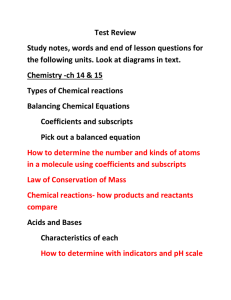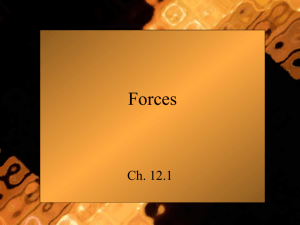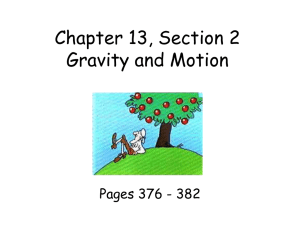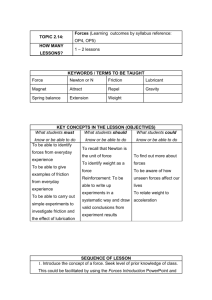Forces, Friction, & Gravity Test Study Guide Forces: • θ Definition: a
advertisement
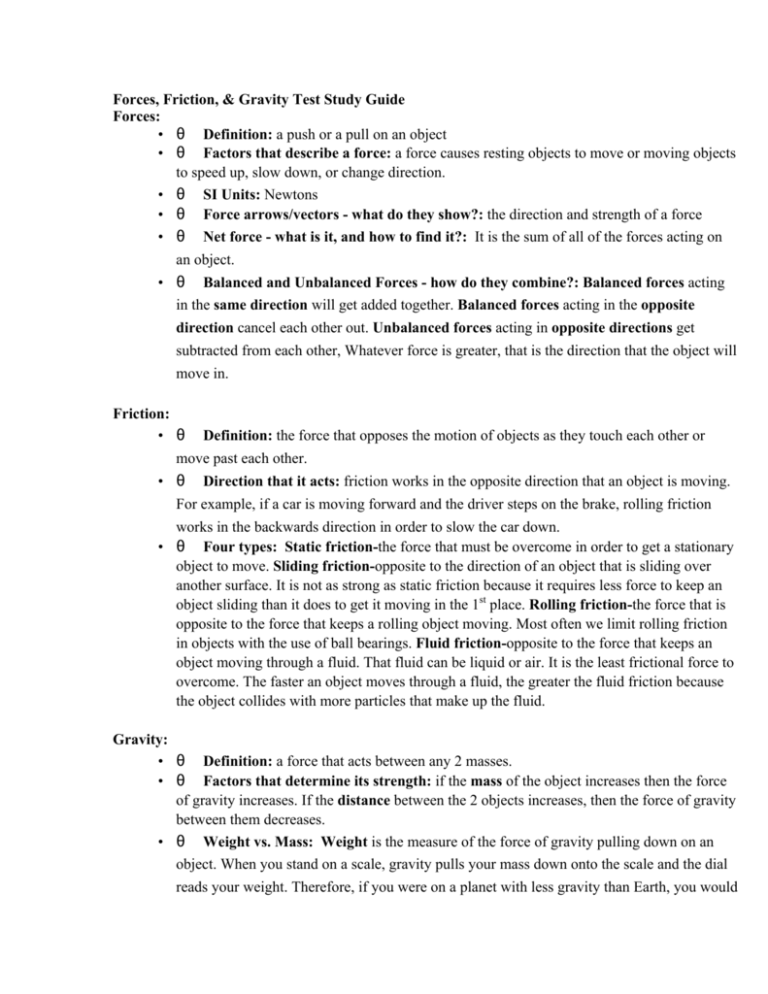
Forces, Friction, & Gravity Test Study Guide Forces: • θ Definition: a push or a pull on an object • θ Factors that describe a force: a force causes resting objects to move or moving objects to speed up, slow down, or change direction. • θ SI Units: Newtons • θ Force arrows/vectors - what do they show?: the direction and strength of a force • θ Net force - what is it, and how to find it?: It is the sum of all of the forces acting on an object. • θ Balanced and Unbalanced Forces - how do they combine?: Balanced forces acting in the same direction will get added together. Balanced forces acting in the opposite direction cancel each other out. Unbalanced forces acting in opposite directions get subtracted from each other, Whatever force is greater, that is the direction that the object will move in. Friction: • θ Definition: the force that opposes the motion of objects as they touch each other or move past each other. • θ Direction that it acts: friction works in the opposite direction that an object is moving. For example, if a car is moving forward and the driver steps on the brake, rolling friction works in the backwards direction in order to slow the car down. • θ Four types: Static friction-the force that must be overcome in order to get a stationary object to move. Sliding friction-opposite to the direction of an object that is sliding over another surface. It is not as strong as static friction because it requires less force to keep an object sliding than it does to get it moving in the 1st place. Rolling friction-the force that is opposite to the force that keeps a rolling object moving. Most often we limit rolling friction in objects with the use of ball bearings. Fluid friction-opposite to the force that keeps an object moving through a fluid. That fluid can be liquid or air. It is the least frictional force to overcome. The faster an object moves through a fluid, the greater the fluid friction because the object collides with more particles that make up the fluid. Gravity: • θ Definition: a force that acts between any 2 masses. • θ Factors that determine its strength: if the mass of the object increases then the force of gravity increases. If the distance between the 2 objects increases, then the force of gravity between them decreases. • θ Weight vs. Mass: Weight is the measure of the force of gravity pulling down on an object. When you stand on a scale, gravity pulls your mass down onto the scale and the dial reads your weight. Therefore, if you were on a planet with less gravity than Earth, you would weigh less. Mass is a measure of the amount of matter (stuff) in an object. Mass is the same • • • • • no matter where in the universe the object is located. θ Direction that it acts: gravity is a force that is downward toward the center of the Earth. θ Free Fall: when the only force acting on a falling object is gravity, the object is said to be in free fall. θ Rate of acceleration due to gravity: an object that is falling experiences a downward acceleration because the force of gravity is unbalanced. θ Newton's and Galileo's theories dealing with gravity and falling objects: falling objects fall at the same rate regardless of their mass as long as there is no air resistance. Therefore, a bowling ball and a ping bong ball will fall at the same rate if they are falling in a place without air resistance, like the moon or outer space. θ Air resistance – definition: the force that acts in the opposite direction (upward) than gravity. It is the force that tries to keep falling objects up. • θ Air resistance and velocity: gravity always causes objects to accelerate downward while air resistance tries to keep objects up. • θ Terminal Velocity - when is it reached?: when the force of air resistance upward equals the force of gravity downward. The falling object no longer accelerates –it falls at a constant rate. • θ Projectile: any object that is thrown is called a projectile. • θ Projectile motion- definition: when an object is thrown outward, gravity will start to ull it downward. This object will hit the ground at the same time as an object that is dropped straight down from the same height as the thrown object.


